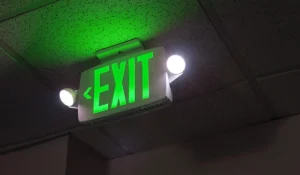Required Testing of Emergency Exit Lighting
03/28/2016
Most of the emergency lighting that is installed in businesses are lighting devices that contain a battery and are simply powered. These devices are also connected to the electrical supply of the building to help keep the battery inside the lighting charged and ready to go if there is a power failure.
In the emergency event of there being a power outage, the emergency lighting is then activated so that the occupants of the building are able to see their way around to be able to exit. Most emergency lighting is only able to stay lit for around 90 minutes, which is the minimum required time by law.
Emergency Lighting and Exit Signs
Exit signs that are lit from the inside operate in the same way as most emergency lights. Many of them have multiple sets of light bulbs because they constantly stay on. One set of the lights that is on most of the time operates at 110 volt electricity which is what the building has hardwired into it.
The second set of lighting only comes on when there is a power failure. Which unfortunately means that signs that look like they are working properly, may actually have the secondary bulbs burnt out and you may not even know.
In large buildings like hospitals and schools, emergency power for the exit signs and emergency lighting is normally powered by an emergency electricity generator. When testing these emergency lighting, the emergency generator is normally tested as well. Which is normally done by either maintenance of the building, or by trained professionals who know the ins and outs of emergency lighting and electricity.
What type of testing does code require?
Fire codes require that all emergency lighting and exit signs need to be inspected, tested and maintained at least once a month. The testing of the signs must include at least a thirty second test of the emergency lighting.
An annual testing and inspection is also required by law, the emergency lighting must also be operated on emergency power for a minimum of ninety minutes. Records that document the testing being done, must be maintained and reviewed by the Fire Marshal or your insurance company.
How do I test them?
Most emergency lighting and exit signs have a “test” button on the outside casing. You can push and use this button for thirty seconds to go and test the emergency bulbs and the back up battery power. This method works well if you have a smaller building with only a handful of signs and lighting, but if you have a large facility you need to contact Titan Alarm to have our professional technicians to come out and test all of the lighting and signage across your campus and facilities.
When testing the exit signs of your buildings you need to check and see if all of your signs are properly lit when in a normal power mode.
When running your annual inspection of your exit signs and emergency lighting make sure you call Titan Alarm and set up an appointment to have one of our trained and experienced professionals to come out to your facilities to run the testing for you.
Key Tips For Testing Emergency Lighting
When it comes to testing and inspecting your emergency exit signs in your commercial facilities, there are only two main components to check to make sure that your emergency signs and lighting are fully operational. Light Bulbs and Batteries.
These are the priority to be inspected and tested during routine maintenance on your facilities. National fire code requires that all of your facility’s emergency lighting and signage be inspected at a minimum of once a month.
There are different models of signage and lighting, some of them will have two different sets of light bulbs that need to be checked during your monthly tests as well. One of the sets runs on the buildings 110v power and the other runs on low voltage in case of a power failure.
These lower voltage light bulbs run off of the built in reserved battery. Unfortunately, a sign that looks like it’s working, may actually fail if there’s a power outage because the low voltage light bulbs have burned out.
Just like the lighting, many of the batteries maintain just enough of a charge to keep the bulbs lit for only a few seconds after being triggered in an emergency. If you don’t go through and test the reserve batteries for a minimum of thirty seconds, you might find out that the lights work every month only to realize that they go out when you need them the most. By testing the lighting for at least another thirty seconds, you can make sure that your batteries don’t only have a misleading surface charge left on them.
Annual testing of emergency signs is a standard code requirement also. This also involves running the lighting under emergency power for a full minimum of required testing of thirty minutes. Documents showing that all of the testing has been maintained need to be available for review in case a fire inspector requests to see them.
To test your emergency lighting, use the “push to test” button on the outside of the light’s housing. Press and hold this button for thirty seconds to test the light bulbs and the batteries to make sure they are functioning properly. If the lights dim instantly or the bulbs are not working, it’s time for some replacements and repair.
For larger facilities that have a lot of devices, or for the annual test, find your circuit breaker or fuse box that supplies your emergency lights power. Turn off the circuit breaker of the facility and make sure all of the lights are functioning through the testing period. If there is other equipment that uses the same circuit, make sure that nothing will get damaged by the interruption.
If you need help doing your monthly inspections, contact Titan Alarm today! Give us a call today 602-680-4567.



